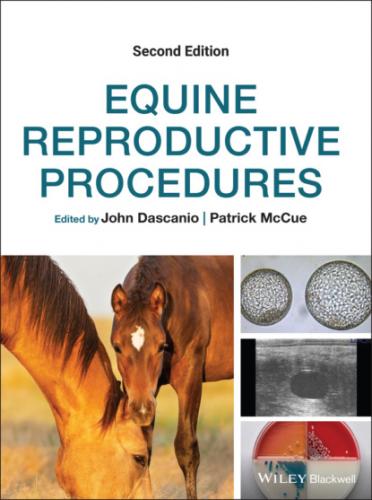Equipment and Supplies
Sedation, previously sterilized 1 or 1.5 m flexible videoendoscope, 200 cm (79 inch) polyethylene tube with 1.7 mm OD (Hibiki high class grade size 5) with a 22 gauge 2.45 cm (1 inch) injection catheter attached to one end, 0.46 diameter and 220 cm (87 inch) long angiocatheter guidewire (Nit‐Vu® Angiodynamics®, Latham, New York, USA), 12 ml plastic syringes, 20 g × 4 cm (1.5 inch) needles, sterile obstetrical sleeves, examination gloves and sterile obstetrical lubricant, lactated Ringer’s solution, uterine lavage tubing, prostaglandin F2α.
Technique
The mare is placed in stocks and sedated appropriately.
The mare’s rectum is evacuated and her perineum prepared routinely for a clean vaginal procedure (see Chapter 3).
Using a sterile obstetrical sleeve and sterile lube, a 1 m flexible endoscope is advanced through the cervix and the uterus insulflated with air.
The scope is passed up to the tip of one horn and the papilla at the utero‐tubular junction is identified (Figure 32.1).
The catheter is fed through the injection port of the endoscope and, with the assistance of the guidewire, the orifice of the papilla is cannulated and the catheter is advanced over the wire and seated in place a few millimeters into the oviductal papilla (Figure 32.2).
The guidewire is withdrawn, and a 20 gauge 4 cm (1.5 inch) needle attached to a syringe with 10 ml of LRS is secured onto the opposite end of the catheter. Fluid is then pulsed through the tube and into the oviduct. Note: it is not uncommon to experience significant resistance when pulsing fluid through the oviduct. This can be counteracted by gentle rotation and slight withdrawal and advancement of the catheter system until fluid flows more freely. Movements should be relatively fine to avoid unseating the catheter.
The procedure is repeated on the contralateral oviductal papilla.
The uterus is lavaged with LRS (see Chapter 34) at the conclusion of the procedure and once daily for 2–3 subsequent days.
Prostaglandin F2α is administered intramuscularly to bring the mare back into estrus and allow her to clean out any contamination.
Figure 32.1 Hysteroscopic view of hydrotubation of the uterine tubes. The guidewire has been advanced a few millimeters from the distal tip of the catheter to facilitate cannulation of the orifice of the uterine tube papilla.
The oviduct is an important link between the ovary and uterus, and is the site of fertilization in vivo. Past research has shown that oviductal masses are not uncommon in mares, but the extent to which these masses can block or interfere with fertilization is unknown and likely only affects a small subset of mares. An accurate diagnosis of oviductal obstruction is difficult, and a presumptive diagnosis is often made by excluding other causes of subfertility. Consequently, diagnosis is often foregone and treatment is instead pursued to resolve potentially blocked oviducts.
Figure 32.2 Hysteroscopic view of the hydrotubation procedure with the catheter seated in the uterine tube papilla.
Further Reading
1 Bradecamp EA, Schnobrich MR. 2016. Hysteroscopic hydrotubation of the oviducts as a treatment for idiopathic infertility in the mare – a retrospective study. Proc Annu Conv Soc Theriogenol 8(3): 337.
2 Inoue Y. 2013. Hysteroscopic hydrotubation of the equine oviduct. Eq Vet J 45: 761–5.
3 Inoue Y, Sekiguchi M. 2017. Clinical application of hysteroscopic hydrotubation for unexplained infertility in the mare. Eq Vet J 50: 470–3.
33 Transvaginal Ovarian Biopsy
Claire E. Card
Western College of Veterinary Medicine, University of Saskatchewan, Canada
Introduction
Transvaginal ovarian biopsy (TVOB) is one method to determine the nature of an ovarian abnormality. The TVOB technique requires specialized equipment including a transvaginal ultrasound unit, a modified spring‐loaded biopsy instrument (Figure 33.1), and personnel trained to perform the procedure. The procedure is indicated when there are ovarian abnormalities of an unknown nature identified by palpation or transrectal ultrasound examination of the ovary. It is also indicated when an ovarian tumor cannot be identified and when ovarian tumor serum biomarker analyses are discordant with the ultrasonographic appearance of the ovary or clinical signs.
The success rate in obtaining samples using this procedure is high. However, the diagnostic value of the ovarian samples is dependent on obtaining samples from the target location and is somewhat limited by the small size of the biopsies obtained (Figure 33.2). Complications associated with the biopsy procedure are uncommon.
Alternative procedures to TVOB to ascertain the nature of an ovarian abnormality include laparoscopic ovarian biopsy and ovariectomy. Ovariectomy is irreversible and may limit fertility.
Equipment and Supplies
Tail wrap, tail rope, non‐irritant soap, roll cotton, stainless steel bucket, paper towels, exam gloves, sterile surgery gloves, sterile rectal sleeves, sterile lubricant, sedation, sterile towel, 14 g × 65 cm (25.5 inch) biopsy instrument, convex or linear array transvaginal ultrasound probe (7.5 or 10 mHz) self‐contained or with a housing, 70% isopropyl alcohol, sterile saline, formalin, sample vials, sterile glass slides, pencil, sedation, N‐butylscopolammonium bromide.
Technique
The self‐contained probe should be wiped with 70% isopropyl alcohol. The biopsy channel should be similarly cold sterilized and then rinsed with sterile saline or a sterile pipette should be inserted into the biopsy channel so the biopsy instrument does not contact an unclean surface.
If ultrasound probe housing is used it should be cold sterilized for a minimum of
